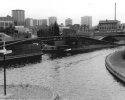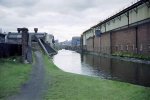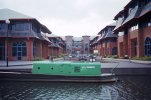Heartland
master brummie
There has been a considerable transformation in recent decades with the canals of Birmingham following the end of general commercial carrying and the newer age of the pleasure and residential boat replacing it. The canal side has also changed with new buildings often of a residential nature as factories and works closed and industry declined. The canals had provided the means of transporting manufactured goods for a lengthy period of years which extended long into the period of the railway age and the need to have coal delivered for industry and domestic use. Even then coal required for electricity generation lasted longer on the waterways and later still there was the carriage of rubbish, phosphorus waste and the by products of town gas making that retained waterways traffic. The greatest change in transport that led to the final demise of canal carrying were the roads and the move of industry away abroad or to other parts of the country.
In the 1970's and 1980's it was still possible to recognise canal heritage in Birmingham, but much has now disappeared falling victim to change.

Some may recall this scene at Farmers Bridge Junction where the land about had been cleared. Gone are the former factories which included a bedstead factory, tube works, a timber yard and former wharves leaving spaces for the developers to work upon.
The island in the foreground had been made during the Second World War in order to enable stop planks to seal of parts of the canal which otherwise was a wide waterway and in the fear that bombing might damage the railway tunnel beneath the canal.
In the 1970's and 1980's it was still possible to recognise canal heritage in Birmingham, but much has now disappeared falling victim to change.

Some may recall this scene at Farmers Bridge Junction where the land about had been cleared. Gone are the former factories which included a bedstead factory, tube works, a timber yard and former wharves leaving spaces for the developers to work upon.
The island in the foreground had been made during the Second World War in order to enable stop planks to seal of parts of the canal which otherwise was a wide waterway and in the fear that bombing might damage the railway tunnel beneath the canal.


